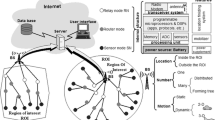Abstract
Wireless Sensor Networks (WSNs) have a broad application range in the area of monitoring and surveillance tasks. Among these tasks, disaster detection or prevention in environmental scenarios is one typical application for WSN. Disasters may for example be forest fires, volcano outbreaks or flood disasters. Here, the monitored events have the potential to destroy the sensor devices themselves. This has implications for the network lifetime, performance and robustness. While a fairly large body of work addressing routing in WSNs exists, little attention has been paid to the aspect of node failures caused by the sensed phenomena themselves. This paper presents a proactive routing method that is aware of the node’s destruction threat and adapts the routes accordingly, before node failure results in broken routes, delay and power consuming route re-discovery. The performance of the presented routing scheme is evaluated and compared to OLSR based routing in the same scenario.
Similar content being viewed by others
Explore related subjects
Discover the latest articles, news and stories from top researchers in related subjects.References
Heinzelman, W. B., Chandrakasan, A. P., & Balakrishnan, H. (2002). An application-specific protocol architecture for wireless microsensor networks. IEEE Transactions on Wireless Communications, 1(4), 660–670.
Intanagonwiwat, D., Govindan, R., Estrin, D., Heidemann, J., & Silva, F. (2003). Directed diffusion for wireless sensor networking. IEEE/ACM Transactions on Networking, 11(1), 2–16.
Kalpakis, K., Dasgupta, K., & Namjoshi, P. (2002). Maximum lifetime data gathering and aggregation in wireless sensor networks. In Proceedings of the 2002 IEEE international conference on networking.
Kulik, J., Heinzelman, W., & Balakrishnan, H. (2002). Negotiation based protocols for disseminating information in wireless sensor networks. ACM Wireless Networks, 8, 169–185.
Liang, Q., & Ren, Q. (2005). Energy and mobility aware geographical multipath routing for wireless sensor networks. In Proceedings of the IEEE wireless communications and networking conference 2005 (pp. 1867–1871).
Lindsey, S., & Raghavendra, C. S. (2002). PEGASIS: power efficient gathering in sensor information systems. In Proceedings IEEE aerospace conference (Vol. 3, pp. 1125–1130).
Manjeshwar, A., & Agrawal, D. P. (2001). TEEN: a routing protocol for enhanced efficiency in wireless sensor networks. In Proceedings of the 15th international parallel and distributed processing symposium (pp. 2009–2015).
Mascolo, C., & Musolesi, M. (2006). SCAR: context-aware adaptive routing in delay tolerant mobile sensor networks. In Proceedings of the 2006 international conference on wireless communications and mobile computing (pp. 533–538).
Musolesi, M., Hailes, S., & Mascolo, C. (2005). Adaptive routing for intermittently connected mobile Ad Hoc networks. In Proceedings of the sixth IEEE international symposium on a world of wireless mobile and multimedia networks (WoWMoM) 2005 (pp. 183–189).
Open-ZB, OpenSource toolset for IEEE 802.15.4 and ZigBee, http://open-zb.net.
OPNET, OPNET modeler, http://opnet.com/solutions/network_rd/modeler.html.
Pandana, C., & Liu, K. J. R. (2005). Maximum connectivity and maximum lifetime energy-aware routing for wireless sensor networks. In Proceedings of IEEE global telecommunications conference GLOBECOM 05 (Vol. 2, 5 p.).
Wenning, B.-L., Lukosius, A., Timm-Giel, A., Görg, C., & Tomic, S. (2008). Opportunistic distance-aware routing in multi-sink mobile wireless sensor networks. In Proceedings ICT mobile-summit 2008 (8 p.).
Wenning, B.-L., Pesch, D., Timm-Giel, A., & Görg, C. (2008). Environmental monitoring aware routing in wireless sensor networks, wireless and mobile networking. In Proceedings of IFIP joint conference on mobile and wireless communications networks (MWCN 2008) and personal wireless communications (PWC 2008) (pp. 5–16).
Author information
Authors and Affiliations
Corresponding author
Rights and permissions
About this article
Cite this article
Wenning, BL., Pesch, D., Timm-Giel, A. et al. Environmental monitoring aware routing: making environmental sensor networks more robust. Telecommun Syst 43, 3 (2010). https://doi.org/10.1007/s11235-009-9191-8
Published:
DOI: https://doi.org/10.1007/s11235-009-9191-8




